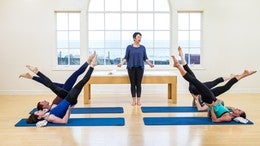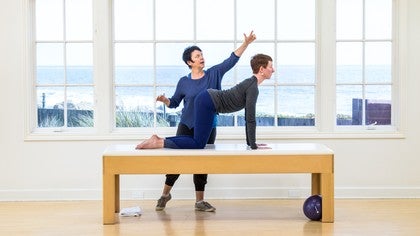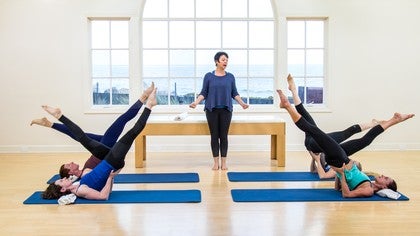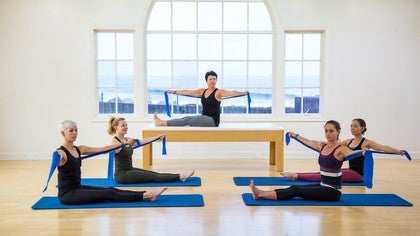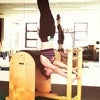Description
About This Video
Transcript
Read Full Transcript
Hi You guys. I'm Kara Reeser and I'm here with Laura Karpinski and um, we're here to do a tutorial the to the subject today and this tutorial is the cervical spine and the objective is to help us be a little bit more clear on how the neck works and how we can use it a little more fully as we're practicing PyLadies I think there's sometimes a little confusion about, you know, oh, should I bring my chin this far down or is it okay to really extend my neck? And so the idea right now is to give you a little bit more sense of how the neck works and that it's okay. It's okay to really use the muscles of the neck to use the joints, the ligaments to get everything moving, um, to help you with your palatium movement. Hopefully by the end of the tutorial, you'll find yourself a little more successful at things like teaser roll-ups, one as we sort of bring the neck into full expression during these movements.
So I want to start just with a couple of reminders. First of all, the neck is full of really powerful muscles in the front and the side in the back. And we want to like the rest of our body, use all those muscles in all directions. So we're going to be looking at full range of motion and really allowing ourselves to tone and strengthen the muscles of the neck. And I think that one of the things that's really key here is we're all trying to help our clients avoid that sort of thrusted headline. You know, it's not like a good look, but it's also produces a little bit of aggravation in the, in the back of the cervical spine for people.
Often you'll see people collect a sort of sort of fatty tissue back here in this sort of dowager's hump. And it's really our belief that if we're using the deep cervical flexors and extensors of the neck more properly, we will actually not need to worry about queuing for this slide because those muscles themselves will thwart the potential of the head gliding. So in this tutorial we're going to give you some small movements to get those muscles going to strengthen. Up and then we're going to keep adding that to each of the plots exercises as we go. So that's the first point is the neck is full of muscles.
Let's go ahead and use them. The image that I want to bring to you, and it's an image that Laura and I actually used in our last as well, which is we were talking about the pelvis in the last tutorial and we were imagining that the pelvis was sort of the last vertebra of your spine, right? Which I, I've heard from a lot of you saying like, oh it was really helpful, right? Cause it helped me move my lumbar spine. Well, this is the same. We're going to now imagine that the head is the first vertebra of the spine, right? So we're not going to be thinking about, oh, I'm going to flex my trunk from here and extend my trunk always from here. But we're actually in the way up to the top where the spine really starts and exactly what Laura is doing right there. This kind of nodding motion, right? That's going to be the first gesture. We're going to be focusing on. So we want to get really clear on this image.
You can just start to articulate one vertebrae at a time from the head. Um, in actually all directions today, we're mostly going to be looking at spinal extension and flection. Okay? So another little demo that we love to give here, and we're stealing this from, um, one of our courses that we do in movement science made simple is looking at actually giving you a way of seeing how the head actually moves on those first con dials of the neck, right? So the atlas, right? So you have your head, right? So this is your head. This is not to scale, but it's a, it's a really fun demonstration, right? And your head sits on that atlas, right? Those first, that first vertebra, and what the head does.
So if I want you to imagine that this had in my head, you know, our noses are facing each other, right? So when you're going into neck flection, there's two things that happen. The, the head is both spinning forward, but it's gliding backwards, right? So I want you to see that again. So I'll put this little tag right here. Here's the nose, right? So if, if this, if this ball was my head and I was doing this gesture, right, what's happening here? Is it spinning forward? But it's sliding back, right? And that's the first movement between your skull and your neck. And that would be the same in extension, right?
So if we were going to go this way or I and Laura can do that with the ball, her head is both spinning back and now gliding forward on those, on those bones, right? And so what happens is that gets these small muscles in both the front and the back of the neck activated prior to some of the, the rest of the joints and what we call that, this movement is, we call it capital flection and capital extension, right? And I love that term because a, the muscles that come and attach in here very deep to um, that attach your skull to your first two Vertebra are actually called capitis muscles. They're in the back, right in here and in the front, right in here. And what I'm suggesting today in this tutorial is that we start to focus a little bit more on getting people to use that movement prior to, um, encouraging the rest of the flection or extension in the spine. So it's really not about taking anything away that you've been doing, but just adding a little nuance, which I think is really gonna make things a little more clear. Okay? So that's our first image. Our first images, okay. Let's, we're going to really imagine that head is the first Vertebra, okay?
And that's going to be in standing, laying down extension flection. Another image that I think can be really helpful, um, is to governance Laura turnaround. And she going to take her two fingers here and put them in the back of her neck, right? And what she's going to mention, Glen, shorten that up a little bit, Laura. Right? She's going to come up to your skull a little more right there. Perfect. So I want you guys to all imagine you can do this to yourself right now.
Why we're on, why we're here together, that you have little teeny rubber bands, right? Right there in the back of your neck. So like the kind you used to wear in your braces, you know, so when Laura goes to nod her head forward, she needs to feel as if the muscles there that attach her skull and her neck are on the stretch. Right? So if she was actually doing something else, like jutting her chin forward, right? She wouldn't get those muscles on the stretch. They would actually be coming closer together. So a lot of times when people think they're doing flection, they're actually frozen. Go ahead and jot that head forward in extension.
Right? So that forward head motion is actually extension. And what we're going to do to solve that is really encouraged flection and encourage this image of just a little bit of stretch on those short muscles in the back. Okay. So that's your number two image, right? So you've got good, you can turn back around. So you've got your head is that vertebrae, you've got these little guys going on the stretch during Dur, during flection and, and of course they're going to shorten during extension. Um, but, but the, the last one I want to talk about is really probably one of my favorite, uh, things to harp on people about, frankly. Um, which is what happens to our neck when we're laying down and we're starting to do all these fancy moves and kicking our legs around and rolling up and down. Um, so we're going to talk about this in this way. I'd like you all to have a towel at home for this, um, for this tutorial to play with.
And I'm going to take this towel and I'm gonna roll up actually just a little bit. And um, I'm going to flip the, this side around so her head's not on it. Laura is going to lay on her back here and um, again, we're gonna put this little roll underneath her neck, right? So number one, what this is doing is it's reminding Laura of where her cervical curve is, right? This is actually a neutral, um, cervical spine, meaning that we are honoring the Lord dotted curve that is natural, right? The only thing I need Laura to do is know where the crown of her head is. So I'm going to come on over here and I'm just going to give the crown of her head a little tap right?
And I'm gonna ask her to do that a lot during this tutorial so that she knows we all need to know where the crown of her head is, right? And where our cervical curve is. So we're going to use this towel as information, neurological feedback right here. So she knows where her curve is, she knows where her crown is, but we're also gonna use this towel to inform us when we're actually pushing down in the towel accidentally like this to get our head up as opposed to what we really want to do is move around that role, right? So there's no moment in your PyLadies practice where I feel like you should be ever pushing down to lift up or pushing down even to get your hips up and over, which we'll look at towards the end of this tutorial. So this, this role, I sort of talk about this as a way of honoring what I call negative space, right? The negative space that exists under her neck is currently being taken up by this role. And we're going to use this, we'll use this in the mat class. We're going to do later on this subject also, but we're going to use this to help Laura understand when she might be making a mistake by, go ahead Lauren d demonstrate that again, pushing down to get her head up right, cause that's actually pushing that cervical curve out and we're gonna, we're gonna honor the way the neck is designed, even though we're gonna move it around a lot. Again, the three year miners were working with before he gets started on the movement, which you're welcome to join in and do with us. Number one, we're, we're imagining the head as the first vertebra.
So if I'm going into flection or an extension, I'm going to start with the movement. Like you saw that little purple ball moving, right? That's going to be our first vertebra. That's our image that, that second thing we're going to keep in mind is this idea of these little rubber bands in the back, right? So that when we go into flection, we're really clear that those little rubber bands are going on this stretch. Cause sometimes we can't tell we're bringing our chin down, but our neck is actually an extension, right? So, so it'll be a good way for you to be tracking it. You can actually touch yourself back there.
I highly recommend that and make sure that's happening. Right? And then the third one is to honor negative space or, and what we're doing today is using a prop to do that. But you could also just use your imagination and just make sure that you're not pushing back in space. But we're going to use this towel, this rolled up towel today, and I suggest you do this at home to sort of get that neurological feedback of when you're making that, um, that choice to push back instead of lift up. So finally we're going to remember the neck is full of muscles and ligaments and tendons that are super powerful and they are meant to lift and move your head around in the world. So let's not be afraid to use them. Here's how we're going to do this.
We're going to start with looking at flection. We're only going to be looking at cervical flection into the, the little bit of the upper thorax. And we're just going to get these movements going and we're going to do all of these protocols in the same format. We're going to do flection in Supine, then we're going to do them in Quadro pad, and then we're going to do it, seed it, and that's should give you a lot of information for what that head is doing in your applaud these protocols. Then we're going to do the same thing in extension. We'll do extension in PR, in, in prone quadro pad and in standing. And then we're gonna look at the transition between coming up and down from sitting to lying down.
And finally we'll finish with a little bit of what it is to invert and honor this negative space. So here we go. So we're going to start with an exercise that we call head lifts. And this actually really comes from Kathy grants repertoire with a lot of me sort of talking into, you know why I think it's functionally so brilliant and important. So basically what I want you to notice here is Laura's head, she's got her role. Her head is in good alignment with her body, right? Some of your clients when they lie down, because their girth is greater in their trunk, their head is too far behind them. So that's when you would add a pillow.
And really frankly, the only time you need to add a pillow is that you want to see a nice alignment between the head and the and the rest of the spine, right? So what we're going to work on here first is these points that we'll keep repeating, which is that when Laura goes to to flex her spine, the first thing we want her to do is float her head up, right? And that's like just being able to bring a piece of paper under her head. Okay? So it's very small. So go ahead and relax that again, Laura. Right now you saw the muscles of her neck kick in. We want that.
We want the neck to be busy. The head is heavy, the neck is going to be in charge of that weight, so she's going to pick up and that's what we're going to call bringing your head in alignment or to neutral. The next move and she's going to do is this little nodding movement that we did with the purple ball, right, and we're going to call that number one capital flection. The next movement, she's going to move the rest of her neck. We're going to call that number two cervical flection. The next thing Laura is going to do is she's going to have to pick up that sternum to come along. We're going to call that pick up your sternum, and then the last moment here, she's going to come into that first upper ab curl and this is what I'm going to suggest we all need to be doing. As we come up to curling, she's going to come down the same sequence that sternum comes down and then check this out guys, she's going to not, she's going to say, I've got a slide that back. She's going to honor negative space coming down.
I don't know if you realize this, but many of you when you're rolling down, many of us are looking for the sensation of feeling our spine on the mat. So we go down and we kind of push our neck back, right? And this causes again a problem cause we're not honoring that natural curvature of the spine, right? We of course sort of flattening out our cervical spines. So we're going to do this together. So you guys can do this along with us, right? You've got your neck roll, you know what you're thinking. And the first thing Laura is going to do is float that head up, right?
She's thinking about those rubber bands. Now she's going to go ahead and do that capitol flection one. She's going to keep that going as she adds that cervical flection to. She's going to keep those two going as she brings the sternum up. Good Lord, you can keep doing that. Capital fluxion Yas, he came out of that. And then number four, she's going to come in punter, Ab Curl, right?
And as she comes down and again, what she's going to spiral over that towel, right? So, um, that is a terrific way to get started. That of course is going to take you into your roll up into your teaser into so many things right now, another way that we often like to help somebody do this on their own is we'll take the towel like this and Laura can grab the edge of the towel. She's holding it under her head and she's gonna assist herself, right? So she's gonna come up to that floating head.
She's going to do that number one capital flection. That number two cervicals flection, that number three sternum lift, that number four upper ab curl. And she's really in a place where those rubber bands are on the stretch. And you could see it's just trembling inside the trunk there, right? Because she's actually now carrying the load, you know, all the way through the system, which is really what we, what we want here, right? And then of course the next step would be fertile. Let the towel go.
Dorsey flex her feet. So she has something to look at. And then she'll go ahead and do her head up her number one, capital her number two cervical flection, number three, sternum number four. And there she is ready to really do a very strong roll up, but she's going to keep those actions going. And then of course she needs to know where the crown of her head is here. Right? And she's good to go.
So that's how we want to sort of kind of think about this carrying on. So let's look what happens if she goes into quad or pet. Okay, great. So in cloud pad, you can imagine the same thing here. We're going to go ahead and just start Laura and extension. So go ahead and come into extension, right?
So I just want you to see how this would be the same in this position. Cause it's also comes up in your plots, right? So she would do that same thing. She would go that number one capital, that number two cervical and that sternum would come through, but her head would keep going, keep going, Laura, and come into flection of the thoracic spine. Right? So as she comes out of that, it would be the same, right? You would come out and then her head again would come back as if that towel were right here. Right. So she's still honoring the full movement.
So she's got the spiral of the skull and one the full neck flection coming through into that sternum change where my hand is right now coming through in three and four. Right. And I feel like this is going to keep Laura from what we often see, which is that dropping the face forward thing, right. This is what we don't want to be doing. That confuses our shoulder blades. It's terrible for a next, it's not a good look. I just highly recommend we find another solution.
So as we get these muscles working in Laura, she won't slide her head forward because she's actually holding on in the front with the muscles that are designed to flex her neck. So that's how we sort of liked to look at that in pet perflection. Right. And then guys, it's going to be the same thing if she seed it. So just sit up really quickly, Laura, like in a spine stretch forward position, and you can just watch how this is the same. So we don't have to labor the point, but I just want you to see it in different positions, right?
So here's the crown of her head, and then she's got that spiral, that capital one, cervical two, here's that sternum, and then there's the upper ab curl, right? And again, Laura's head is in good alignment with her spine right now. We're often, again, what I see is something that's a little bit more thrusted forward. Right now I'm going to say to you that I've had great success with this type of teaching, helping people with that little bit of roundness. They often get up in the upper neck. So I'm here to tell you, this is like, like we really, we really, we really know this is helpful. Like really? So that's good. All right, so let's look at some extension and now we've got Laura prone. She's on her tummy, right? Because now we're going to be looking at extension.
Okay, so extension is the same, right? We're going to honor negative space, right? So Laura is going to to be aware that she doesn't want to drop the front of her throat down. Right? She's going to let her head come up. We call this coming up to the level of the sternum is what we say. But you just want to lift it up so the head's in neutral lower. You've got your neck flex a little, let's start a little more natural right there. Exactly.
So now she's going to do that same thing in extension. She's going to go capital extension one, cervical extension two. The only difference is she's going to bring that sternum through a little sooner when we're doing extensions. So she's going to get that term going and then she's in that right. And then she's got really clear cervical extension as part of her thoracic extension. Right? So let's come back down Laura, we'll look at that again.
Now, some of you are going to say to me, Oh but Carrie, you know you don't want people like break in the back of their neck or like you know, but, but she's not going to because she's using her muscles, right? Gravity's pulling her down. So if she broke at the back of her neck, it would be because she dropped her throat forward. Right. You see what I'm saying? If she honors that negative space, she's simply going to be doing like super awesome extension. Right? So let's just try that again. She's going to bring her head to the level. Great. She knows where that is.
Cause she's learned where the crown of her head is. Right? Remember we did that tappings because we're going to all be aware of the crown of your head and then she's going to go cervical our capital one cervical two and then right away she starts coming up. She's going to get that call, those a breastbone to come with and then she's up in her right. And what I love to think of here is that the crown of the head is really going straight up towards the ceiling here, right? So she's not, what I often see people do is protect their next one, right? They do this, which is dropping the neck forward, or they keep their neck flexed, right? Which means this guy is taking all the load for that extension, right? We want to share the load and come on down. Great. Okay. So again, before you start teaching this, you're gonna want to feel and have a relationship with this on your own body.
So it's meaningful to you, but it's, it's functionally just a really nice way to set this up for people. Okay, so let's look at it in quarter pad, right? So it's the same in quadrant pad. So we'll have Laura in this position start a little bit more table tops so we can sort of watch her go into extension from the top. Right? But again, she's not going to be dropping down in the front of her throat.
Could you just demonstrate that, right? Like this is, this would be not helpful extension. It's extension but not supported. But what we'd rather see her do is do that number one, do that to get that sternum through. And again, she's in really, really good cervical extension, crown of the head reaching up and I feel like she's able to honor that spine. Remember? Go ahead and come back out of that Laura into tabletop. We're thinking of the head as that first vertebra here. We'll do it virtually together. Here she goes, we are here.
And we're just going to look at extension that comes up in polite ease in something like back bend or um, a variety of ways with the, the head and extension. Standing is, is the trickiest because gravity is actually pulling her head back, right? So if she's not really using, I'm going to move you forward and I'm gonna come behind you if she's not really using the front of her neck, he centric Lee guys. So you've got to think about that, right? The front of her neck is contracting while the muscles are on the stretch to control the weight of her head. This is how you get those gorgeous, throbbing neck muscles, which we love. Okay, so here we go, Laura. I'm gonna. You're going to do this. Here's the crown of her head.
She's going to do that same movement first. That one too. Now remember that sternum has to come right with her and she's going to come into a bit of a back bend here. Now she knows how to control that, right? And then she's going to come out of it from the sternum, right? And then she's going to do that little spiral. Gorgeous. Right now, at first you're going to have to support people or they could use the magical and wondrous towel, right? So oftentimes, and we'll do this in class together in just a bit, I'll, I'll give my clients the towel there and then she can start to practice this on her own and start. And then what you could do is just give herself a little less support with the towel and see if she could hold it. And if she can't, she uses the towel as her partner. Right. But again, that's going to create a lot of sensation in her front of her neck.
Good. Good. Great. Laura. Thank you. Um, so what I want to say about that is doing, doing this practice, your clients are going to report in, Hey, I really feel my neck muscles working and when you're going to say awesome, it's a good group of muscles to work when you're moving your head around the world because that's what they're for, right? You can't really move your head around with your outs. So it's a, it's a really, um, but they will have sensation and you will get sore as you start to strengthen. So we just want to remind you that that's, that's fine. It's just like getting sore in your glutes. It's a good thing. We're going to now, so, so, so this is your base.
Now this is what you have is your base. You have this idea of like, okay, flection extension. I'm spinning and gliding, I'm using my neck muscles. But then what gets complicated, what he said, sometimes you have to go from sitting up to laying down, from laying down to sitting up, right? And all of a sudden you've got this like chicken dance going on in your neck again, right? So let's, let's, let's share a couple of ways. We like to help people control their neck, right? So Laura is going to start seated. And um, now if you studied with me in the past, you know, if you've done this many ways, sometimes we'd put a yoga block on your head. Sometimes we tell you, your eyes have paint brushes. It's all the same concept. It's all the idea that you could now have some neuro motor control, right? So Lord just started to do a sit up, or you know, like Kathy grant style set up where you, you lose neuroma motor control of your head.
So she's gonna go back and a lot of times what you're going to see is this kind of jutting head right there, right? So she really demonstrated that, well God love all our friends who don't know how to neuro motor control their headset yet they're about to figure it out, right? So what she's going to do, we have to give her some, some kind of information about how to know where her head is in space as the rest of her spine is changing. So this is what I'm trying today. Okay. We're going to take the towel, right? And what Laura was going to do with this towel is she's going to keep it at eye level. Now she's going to be trying to keep her eyes on. You can actually bend it. I think you'll like this better. Um, she's going to bend it and as she goes down with her spine, right, she's moving her pelvis, she, the towel is gonna come down and she's gonna try to keep her eyes on that horizon, on that towel, which is also going to keep the crown of her head facing the ceiling. And then she's going to do that spiral where she comes out as if the tower there. Okay.
So now she's gonna do her float lift and roll the head and she's going to have that towel there and she's going to start coming up and she's going to let that Chin lift up a little bit. Uh Huh. Great. Right now, another way I played with this today is I put the, the towel on the crown of my head to get crown of the head awareness, right? So trying to keep the crown of the head facing the ceiling. So this is another way you could come up with your own way. But the idea is that th the neck is going to move into that capitol flection right in there. I know it's hard. And then she's got a d rotate that slide. She's got to come out of that. Right. And to come up and yeah, give your friends a little love. Hold their feet. Yeah, this is very hard.
But again, what I want you to see as she brings that head up in that classical way we just taught and then she's going to try to get that crown of the head back up to the ceilings. Her cervical spine will go back into natural extension, right? So that's sort of a helpful thing to know how to do before you do a roll up where you have to figure out how to control your head in that plane of gravity where it's pulling at you. Um, so it just kinda be helpful. We'll be using the town, the mat costs later for the cervical spine in roll up in an all your plots protocols. So you'll see how we apply that. This is addressing what happens when we do something like rollover short spine, long spine. We're doing any kind of inversion protocol, right? So now we're back to this conversation about negative space, right?
So I've got the neck roll back under Laura's neck. Now this might seem controversial to a lot of people cause be like, oh my God, you can't put something under your neck if you're going to roll onto your neck. But guess what? We're not going to roll onto the neck. That's what's so cool about this. We're going to roll up into the shoulder blades and we're going to still have some cervical a space there.
There will be some pressure change on this towel as her hips get higher. But what we're trying to avoid is that, let's say you were going into roll over Laura, um, and let's just watch her neck for a second. What we often see happen is immediately the neck flattens out. So as she goes to lift her hips, right? Cheat pushed down, right? So instead, you know, and you're going to hear me say this a lot, I'll say, get your chin off your throat, Chin off your throat.
What I'm saying when I say that is honor that negative space, don't let the inversion pull your neck back, right? So what Laura is going to be doing is two fold. She's going to be honoring negative space, right? You can come up with another term for that. It's just what I use. She's also going to be bringing her scapula under her rib cage closer towards the spine so that her scapula bases her inversion.
This is going to help her neck. So what she's going to play with here is her legs are going to come over and you see she's going to be really awesome at knowing where the crown of her head is. Yes, you are awesome and right and not really crunching down on that neck. And then she's gonna roll down and she's gonna feel how that space even gives way more. So again, there'll be some compression, right? Because your body weight is changing, but it's certainly not the first thing that you want to feel.
And you want to try to hold back from pushing that neck back in the mat as much as you can. As you're playing with your inversions. You know, in Kathy Grant Studio in the little studio at Tisch School of the arts, when we learned, we always did conversions with the little neck pillow under our neck. And it wasn't until I started to really study the cervical spine more that I was like, of course she did that she was a genius. You know, like that made sense. It was a way of saying, hey guys, be aware, don't, don't smush the, don't smush the cockroach with your neck or wa or whatever. You know, the images are out there. That's Kinda Gross, right? Yeah. Right. So you could see then how this would go ahead and come up to see the Laura, how this would apply, right. Um, to, you know, roll all of your plot, these exercises. The question is really where is your head? You know, where is your head going in space? How is it, how is your neck changing with those movements?
Um, and when is it neutral and how do you know, you know, it's Kinda hard to know where your head is in space. So, um, what we're gonna do is do a mat class together. Right now, and you're gonna stay tuned. I hope so, that you can now practice this. I'm going to try to give you some, some real, um, ways of getting information about where your head is in space without somebody like teaching you a private, right? So something you can do at home, something you can do, um, when you're just sort of messing around and, and hopefully if you're a teacher, something you would teach to your clients when it is meaningful enough to you to share. So that's where we're headed.
The Teacher's Corner: Neck and Shoulder Awareness
Comments
You need to be a subscriber to post a comment.
Please Log In or Create an Account to start your free trial.
